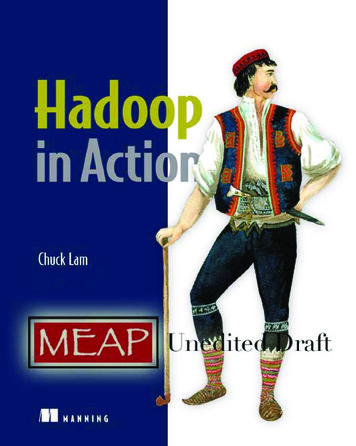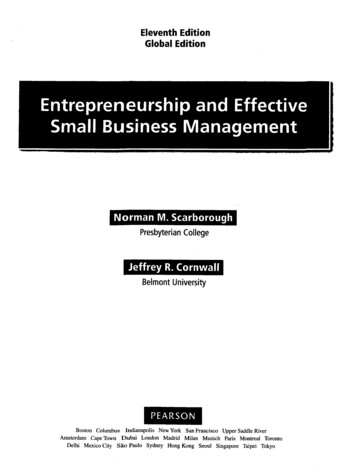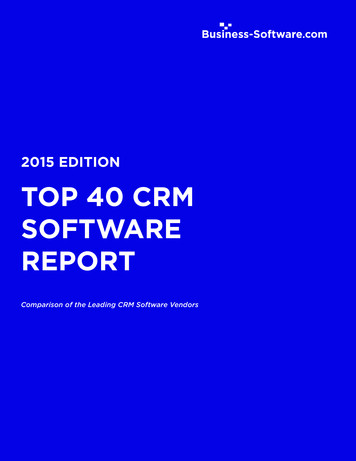
Transcription
MEAP EditionManning Early Access ProgramCopyright 2010 Manning PublicationsFor more information on this and other Manning titles go towww.manning.com
TABLE OF CONTENTSPART1 Hadoop - A Distributed Programming FrameworkCHAPTER 1Introducing HadoopCHAPTER 2Starting HadoopCHAPTER 3Components of HadoopPART 2 - Hadoop in ActionCHAPTER 4Writing basic MapReduce programsCHAPTER 5Advanced MapReduceCHAPTER 6Programming practicesCHAPTER 7CookbookCHAPTER 8Managing HadoopPART 3 - Hadoop Gone WildCHAPTER 9Running Hadoop in the cloudCHAPTER 10 Programming with PigCHAPTER 11 Hive and the Hadoop herdCHAPTER 12 Case studiesAPPENDIXHDFS file commands
Part 1Hadoop–A DistributedProgramming FrameworkPart 1 of this book introduces the basics for understanding and using Hadoop.We describe the hardware components that make up a Hadoop cluster, as wellas the installation and configuration to create a working system. We cover theMapReduce framework at a high level and get your first MapReduce program upand running.
1Introducing HadoopThis chapter covers The basics of writing a scalable,distributed data-intensive programUnderstanding Hadoop and MapReduceWriting and running a basic MapReduce programToday, we’re surrounded by data. People upload videos, take pictures on theircell phones, text friends, update their Facebook status, leave comments aroundthe web, click on ads, and so forth. Machines, too, are generating and keepingmore and more data. You may even be reading this book as digital data on yourcomputer screen, and certainly your purchase of this book is recorded as data withsome retailer.1The exponential growth of data first presented challenges to cutting-edgebusinesses such as Google, Yahoo, Amazon, and Microsoft. They needed to gothrough terabytes and petabytes of data to figure out which websites were popular,what books were in demand, and what kinds of ads appealed to people. Existingtools were becoming inadequate to process such large data sets. Google was the firstto publicize MapReduce—a system they had used to scale their data processing needs.1Of course, you’re reading a legitimate copy of this, right?3
4CHAPTER 1Introducing HadoopThis system aroused a lot of interest because many other businesses were facing similarscaling challenges, and it wasn’t feasible for everyone to reinvent their own proprietarytool. Doug Cutting saw an opportunity and led the charge to develop an open sourceversion of this MapReduce system called Hadoop. Soon after, Yahoo and othersrallied around to support this effort. Today, Hadoop is a core part of the computinginfrastructure for many web companies, such as Yahoo, Facebook, LinkedIn, andTwitter. Many more traditional businesses, such as media and telecom, are beginningto adopt this system too. Our case studies in chapter 12 will describe how companiesincluding New York Times, China Mobile, and IBM are using Hadoop.Hadoop, and large-scale distributed data processing in general, is rapidly becomingan important skill set for many programmers. An effective programmer, today, musthave knowledge of relational databases, networking, and security, all of which wereconsidered optional skills a couple decades ago. Similarly, basic understanding ofdistributed data processing will soon become an essential part of every programmer’stoolbox. Leading universities, such as Stanford and CMU, have already startedintroducing Hadoop into their computer science curriculum. This book will help you,the practicing programmer, get up to speed on Hadoop quickly and start using it toprocess your data sets.This chapter introduces Hadoop more formally, positioning it in terms ofdistributed systems and data processing systems. It gives an overview of the MapReduceprogramming model. A simple word counting example with existing tools highlightsthe challenges around processing data at large scale. You’ll implement that exampleusing Hadoop to gain a deeper appreciation of Hadoop’s simplicity. We’ll also discussthe history of Hadoop and some perspectives on the MapReduce paradigm. But let mefirst briefly explain why I wrote this book and why it’s useful to you.1.1Why “Hadoop in Action”?Speaking from experience, I first found Hadoop to be tantalizing in its possibilities, yetfrustrating to progress beyond coding the basic examples. The documentation at theofficial Hadoop site is fairly comprehensive, but it isn’t always easy to find straightforward answers to straightforward questions.The purpose of writing the book is to address this problem. I won’t focus on the nittygritty details. Instead I will provide the information that will allow you to quickly createuseful code, along with more advanced topics most often encountered in practice.1.2What is Hadoop?Formally speaking, Hadoop is an open source framework for writing and running distributed applications that process large amounts of data. Distributed computing is awide and varied field, but the key distinctions of Hadoop are that it is Accessible—Hadoop runs on large clusters of commodity machines or on cloudcomputing services such as Amazon’s Elastic Compute Cloud (EC2).
5What is Hadoop?ClientClientClientHadoop clusterFigure 1.1 A Hadoop cluster has many parallel machines that store and process large datasets. Client computers send jobs into this computer cloud and obtain results. Robust—Because it is intended to run on commodity hardware, Hadoop is architected with the assumption of frequent hardware malfunctions. It can gracefullyhandle most such failures.Scalable—Hadoop scales linearly to handle larger data by adding more nodes tothe cluster.Simple—Hadoop allows users to quickly write efficient parallel code.Hadoop’s accessibility and simplicity give it an edge over writing and running largedistributed programs. Even college students can quickly and cheaply create their ownHadoop cluster. On the other hand, its robustness and scalability make it suitable foreven the most demanding jobs at Yahoo and Facebook. These features make Hadooppopular in both academia and industry.Figure 1.1 illustrates how one interacts with a Hadoop cluster. As you can see, aHadoop cluster is a set of commodity machines networked together in one location.2Data storage and processing all occur within this “cloud” of machines. Different userscan submit computing “jobs” to Hadoop from individual clients, which can be theirown desktop machines in remote locations from the Hadoop cluster.Not all distributed systems are set up as shown in figure 1.1. A brief introduction toother distributed systems will better showcase the design philosophy behind Hadoop.2While not strictly necessary, machines in a Hadoop cluster are usually relatively homogeneous x86 Linuxboxes. And they’re almost always located in the same data center, often in the same set of racks.
61.3CHAPTER 1Introducing HadoopUnderstanding distributed systems and HadoopMoore’s law suited us well for the past decades, but building bigger and bigger serversis no longer necessarily the best solution to large-scale problems. An alternative thathas gained popularity is to tie together many low-end/commodity machines togetheras a single functional distributed system.To understand the popularity of distributed systems (scale-out) vis-à-vis hugemonolithic servers (scale-up), consider the price performance of current I/Otechnology. A high-end machine with four I/O channels each having a throughput of100 MB/sec will require three hours to read a 4 TB data set! With Hadoop, this samedata set will be divided into smaller (typically 64 MB) blocks that are spread amongmany machines in the cluster via the Hadoop Distributed File System (HDFS). Witha modest degree of replication, the cluster machines can read the data set in paralleland provide a much higher throughput. And such a cluster of commodity machinesturns out to be cheaper than one high-end server!The preceding explanation showcases the efficacy of Hadoop relative to monolithicsystems. Now let’s compare Hadoop to other architectures for distributed systems.SETI@home, where screensavers around the globe assist in the search for extraterrestriallife, represents one well-known approach. In SETI@home, a central server stores radiosignals from space and serves them out over the internet to client desktop machinesto look for anomalous signs. This approach moves the data to where computation willtake place (the desktop screensavers). After the computation, the resulting data ismoved back for storage.Hadoop differs from schemes such as SETI@home in its philosophy toward data.SETI@home requires repeat transmissions of data between clients and servers. Thisworks fine for computationally intensive work, but for data-intensive processing,the size of data becomes too large to be moved around easily. Hadoop focuses onmoving code to data instead of vice versa. Referring to figure 1.1 again, we see boththe data and the computation exist within the Hadoop cluster. The clients send onlythe MapReduce programs to be executed, and these programs are usually small (oftenin kilobytes). More importantly, the move-code-to-data philosophy applies within theHadoop cluster itself. Data is broken up and distributed across the cluster, and as muchas possible, computation on a piece of data takes place on the same machine wherethat piece of data resides.This move-code-to-data philosophy makes sense for the type of data-intensiveprocessing Hadoop is designed for. The programs to run (“code”) are orders ofmagnitude smaller than the data and are easier to move around. Also, it takes moretime to move data across a network than to apply the computation to it. Let the dataremain where it is and move the executable code to its hosting machine.Now that you know how Hadoop fits into the design of distributed systems, let’s seehow it compares to data processing systems, which usually means SQL databases.
Comparing SQL databases and Hadoop1.47Comparing SQL databases and HadoopGiven that Hadoop is a framework for processing data, what makes it better than standardrelational databases, the workhorse of data processing in most of today’s applications?One reason is that SQL (structured query language) is by design targeted at structureddata. Many of Hadoop’s initial applications deal with unstructured data such as text.From this perspective Hadoop provides a more general paradigm than SQL.For working only with structured data, the comparison is more nuanced. Inprinciple, SQL and Hadoop can be complementary, as SQL is a query language whichcan be implemented on top of Hadoop as the execution engine. 3 But in practice, SQLdatabases tend to refer to a whole set of legacy technologies, with several dominantvendors, optimized for a historical set of applications. Many of these existing commercialdatabases are a mismatch to the requirements that Hadoop targets.With that in mind, let’s make a more detailed comparison of Hadoop with typicalSQL databases on specific dimensions.SCALE-OUT INSTEAD OF SCALE-UPScaling commercial relational databases is expensive. Their design is more friendlyto scaling up. To run a bigger database you need to buy a bigger machine. In fact,it’s not unusual to see server vendors market their expensive high-end machines as“database-class servers.” Unfortunately, at some point there won’t be a big enoughmachine available for the larger data sets. More importantly, the high-end machinesare not cost effective for many applications. For example, a machine with four timesthe power of a standard PC costs a lot more than putting four such PCs in a cluster.Hadoop is designed to be a scale-out architecture operating on a cluster of commodity PC machines. Adding more resources means adding more machines to theHadoop cluster. Hadoop clusters with ten to hundreds of machines is standard. Infact, other than for development purposes, there’s no reason to run Hadoop on asingle server.KEY/VALUE PAIRS INSTEAD OF RELATIONAL TABLESA fundamental tenet of relational databases is that data resides in tables having relational structure defined by a schema. Although the relational model has great formalproperties, many modern applications deal with data types that don’t fit well into thismodel. Text documents, images, and XML files are popular examples. Also, large datasets are often unstructured or semistructured. Hadoop uses key/value pairs as its basic data unit, which is flexible enough to work with the less-structured data types. InHadoop, data can originate in any form, but it eventually transforms into (key/value)pairs for the processing functions to work on.FUNCTIONAL PROGRAMMING (MAPREDUCE) INSTEAD OF DECLARATIVE QUERIES (SQL)SQL is fundamentally a high-level declarative language. You query data by stating the resultyou want and let the database engine figure out how to derive it. Under MapReduce you3This is in fact a hot area within the Hadoop community, and we’ll cover some of the leading projects inchapter 11.
8CHAPTER 1Introducing Hadoopspecify the actual steps in processing the data, which is more analogous to an executionplan for a SQL engine. Under SQL you have query statements; under MapReduceyou have scripts and codes. MapReduce allows you to process data in a more generalfashion than SQL queries. For example, you can build complex statistical models fromyour data or reformat your image data. SQL is not well designed for such tasks.On the other hand, when working with data that do fit well into relational structures,some people may find MapReduce less natural to use. Those who are accustomed tothe SQL paradigm may find it challenging to think in the MapReduce way. I hope theexercises and the examples in this book will help make MapReduce programmingmore intuitive. But note that many extensions are available to allow one to takeadvantage of the scalability of Hadoop while programming in more familiar paradigms.In fact, some enable you to write queries in a SQL-like language, and your query isautomatically c
Scalable—Hadoop scales linearly to handle larger data by adding more nodes to the cluster. Simple—Hadoop allows users to quickly write effi cient parallel code. Hadoop’s accessibility and simplicity give it an edge over writing and running large distributed programs. Even college students can quickly and cheaply create their own











